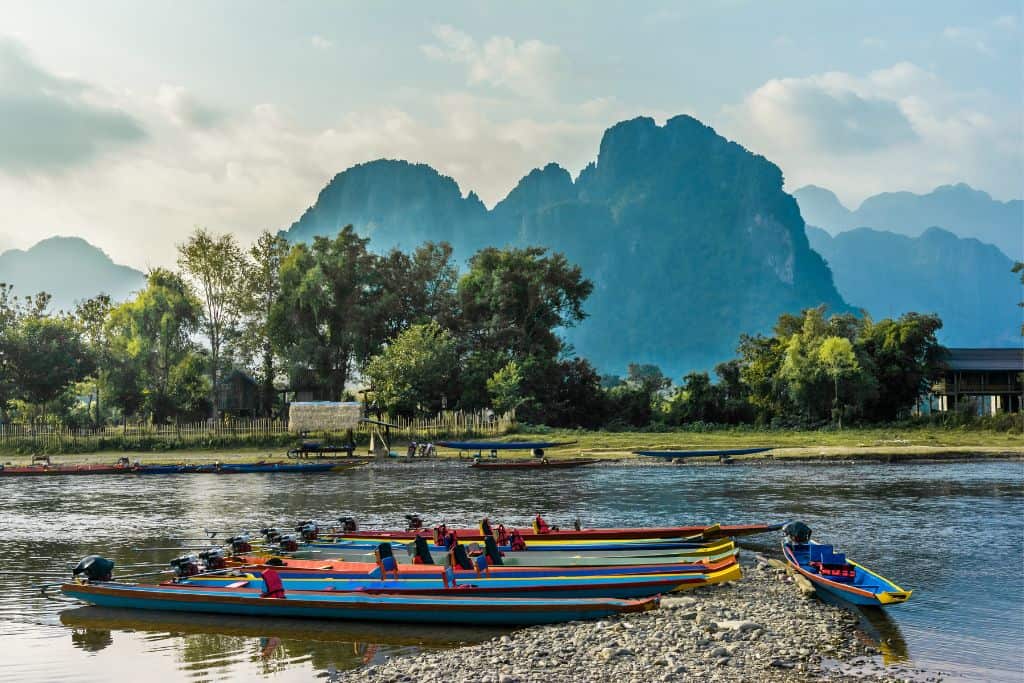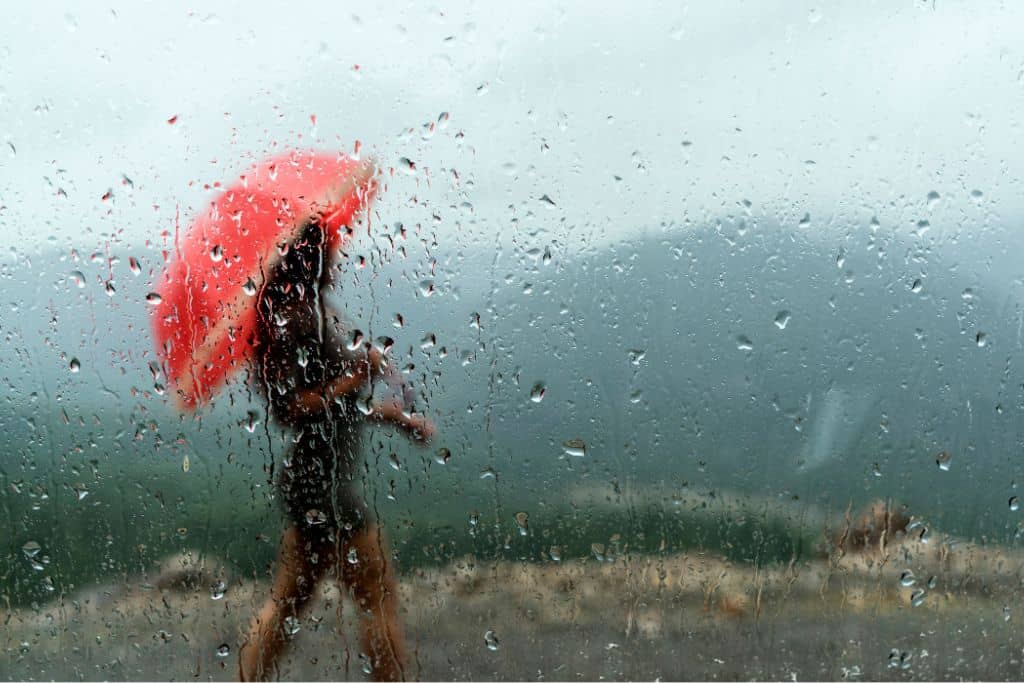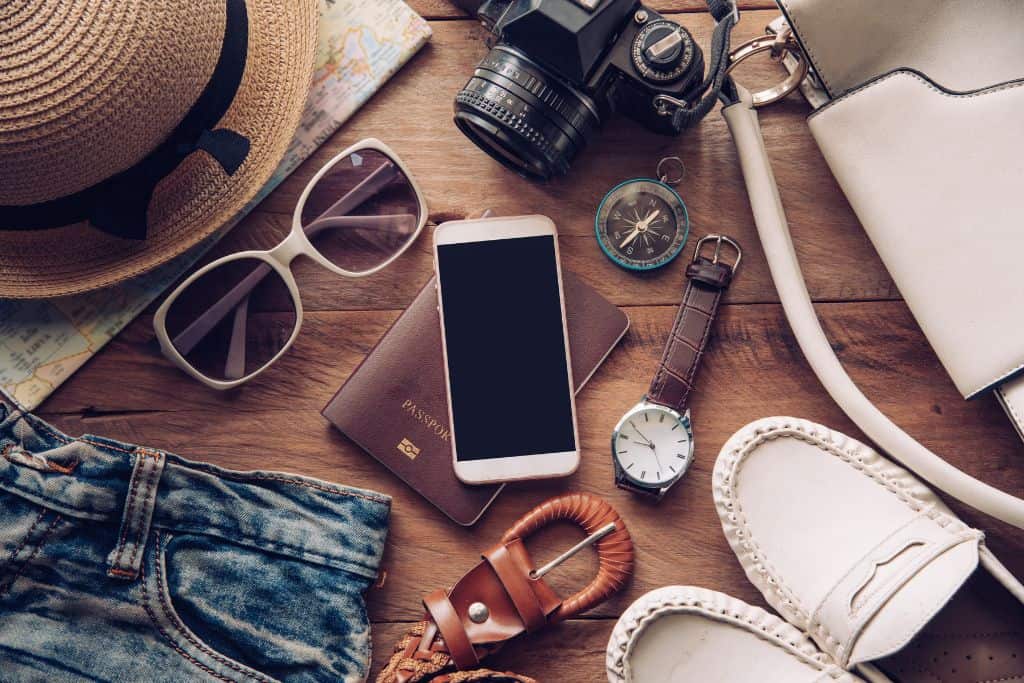11 Useful Tips For Traveling to Laos
Looking for tips for traveling to Laos?
Nestled in the heart of Southeast Asia, Laos is a hidden gem that captivates travelers with its serene landscapes, rich cultural heritage, and warm hospitality.
Unlike its more bustling neighbors, Laos offers a peaceful escape where time seems to slow down, allowing visitors to fully immerse themselves in the beauty of its untouched nature and ancient traditions.
Traveling to Laos
Travel to Asia is increasing in popularity. Follow these 11 tips for traveling to Laos to make your trip easier and more enjoyable. We’ll cover the following categories.
- Travel Requirements
- General Tips
- Health and Safety Tips
- Transportation Tips
- Documentation Tips
- Environmental Awareness Tips
- Weather Tips
- Packing Tips
- Connectivity Tips
- Cultural Sensitivity Tips
- Food and Drink
The more information you have, the more enjoyable your adventure to Laos can be. Some of these tips are more important than others, like travel requirements, but all of them are useful. Together, these tips for traveling to Laos will help prepare you for the best adventure ever.
1. Travel Requirement Tips for Traveling to Laos
Let’s start at the beginning. What do you need to actually get into the country legally? These travel requirements are for Americans, but please check your specific country’s required travel documents for spending time in Laos. Rules and regulations for your country may be different than those for the United States.
Passports
A passport is required to enter Laos. Your passport must have more than 6 months remaining before it expires. You must also have at least 2 blank pages for visas.
The U.S. Embassy site suggests you carry a copy of your passport with you at all times, separate from your actual passport.
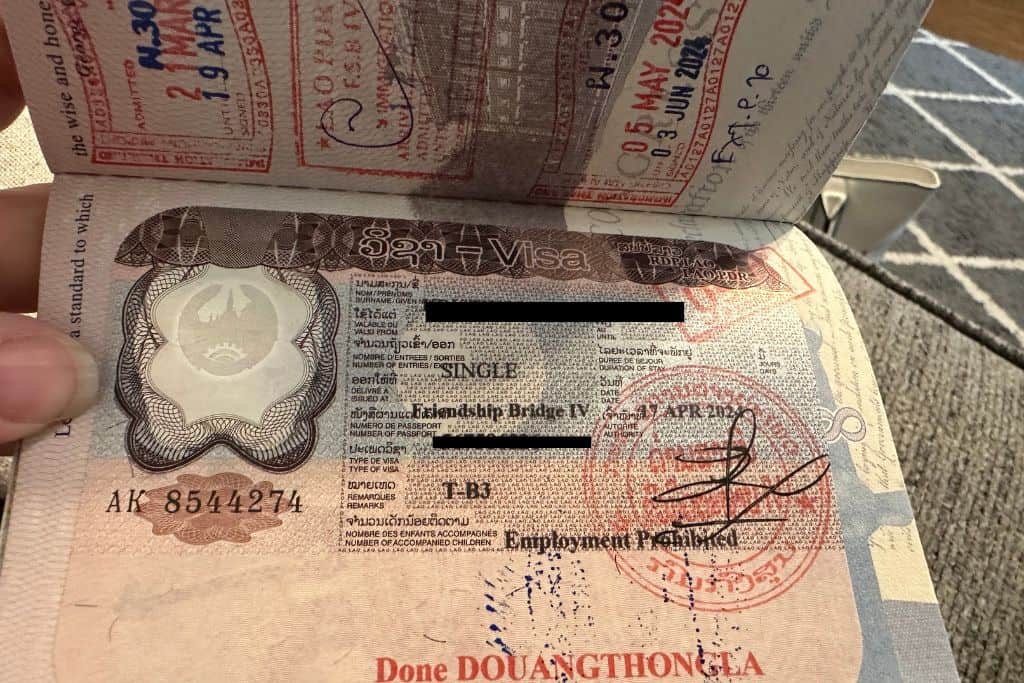
Visas
A visa upon arrival is available for American tourists and normally permits a visit of up to 30 days. These can be obtained at most land border crossings, international airports, and at the Friendship Bridge. I obtained mine at the Friendship Bridge when I crossed into Laos from Thailand on my way to the Mekong River Slow Boat ride to Luang Prabang.
The bus bringing me and many other travelers to Laos stopped at a pre-border crossing station to make sure our passports were valid. Two passport-style photos were required for the visa application upon arrival.
Even though I had extras, I forgot to bring them. Not to worry since they snapped a new photo and the charge was around $3.00. If your passport photos show overly colorful clothing or bold jewelry, you will be asked to take new photos. Make sure yours are simple to avoid paying for additional photos.
Crisp U.S. Money to Pay the Fees
Once at the border crossing area, we paid $40.00 USD for the tourist visa and $1.00 to physically enter Laos. Make sure you have crisp US bills. I had about $200 cash on me in twenties and they turned down nearly all of them. Set aside fresh, clean, uncreased or unmarked bills to pay for the visa fees.

The lady told me the bank will not accept anything but fresh clean bills and they are picky!
The U.S. Embassy site also states they accept Laotian kip and credit cards, but that option was not mentioned and I paid in cash. My best suggestion is to just have the required payment in new crisp, freshly-printed bills. Ask your bank specifically for these bills if necessary.
For more information, please review the U.S. Embassy in Laos site. You can also review the related site for Laos for your own country if you are not American.
2. General Tips for Traveling to Laos
Respect Local Customs
Lao culture is deeply rooted in Buddhism, so dress modestly, especially when visiting temples. This means covering your shoulders and low necklines, and wearing shorts or skirts to cover your knees.

Remove your shoes before entering a temple, and people’s houses, and avoid pointing your feet at religious artifacts or people. Also avoid touching people on the head, as these actions are considered disrespectful.
Learn Basic Phrases
Learning a few basic Lao phrases can go a long way in making a positive impression on the locals. Simple greetings like “Sabaidee” (hello) and “Khawp jai” (thank you) are appreciated.
- Hello: Sabaidee (sah-bai-dee)
- Thank you: Khawp jai (khop jai)
- Yes: Jao (chow)
- No: Baw (baw)
- Excuse me / Sorry: Khaw thot (khaw thawd)
- How much?: Thao dai? (tao dai)
- Please: Khaw nyin (khaw nyin)
- Water: Nam (naam)
- Where is the bathroom?: Hong nam yu sai? (hong nam yoo sai)
- Help!: Chuay duay! (chuay doo-ay)
These basic phrases will help you navigate and communicate better with the locals in Laos. Throughout my time in Laos I usually found people who could help me in English, but if all else fails, simple gestures or motions can help you be understood.
Currency
The official currency is the Lao Kip (LAK). While US dollars and Thai Baht are widely accepted, it’s handy to have some Kip for smaller purchases. ATMs are available in major cities.

While in Laos, I paid for most smaller charges using Lao Kip. I suggest getting a small amount of Kip before your travels or at an ATM once in Laos. You can take out more if staying longer, but approximately $50 should be enough for a few days if using a credit card for larger purchases like hotels.
Bargaining
Bargaining is common in markets and with tuk-tuk drivers. Start with a lower price and negotiate to find a mutually agreeable price. Be respectful and enjoy your haggling, but remember this is their livelihood. Do not make a scene if they do not accept your lower offer. You may be trying to get them to accept a lower price, but keep in mind how much worth the actual difference is.
For example, at the time of writing this post, 1000 LAK = $0.4 USD. So trying to get them to accept a 1000 difference is actually just pennies. Be aware of the currency conversion rate and haggle fairly and within reason.
3. Safety in Laos
Traveling to Laos can be an enriching and memorable experience. To ensure your trip is both enjoyable and safe, here are some safety tips for first-time visitors. Laos is generally safe and following these tips for traveling to Laos will keep you even safer.
Health Tips for Traveling in Laos
Following these health tips will help you have the best time possible without falling ill during your visit.
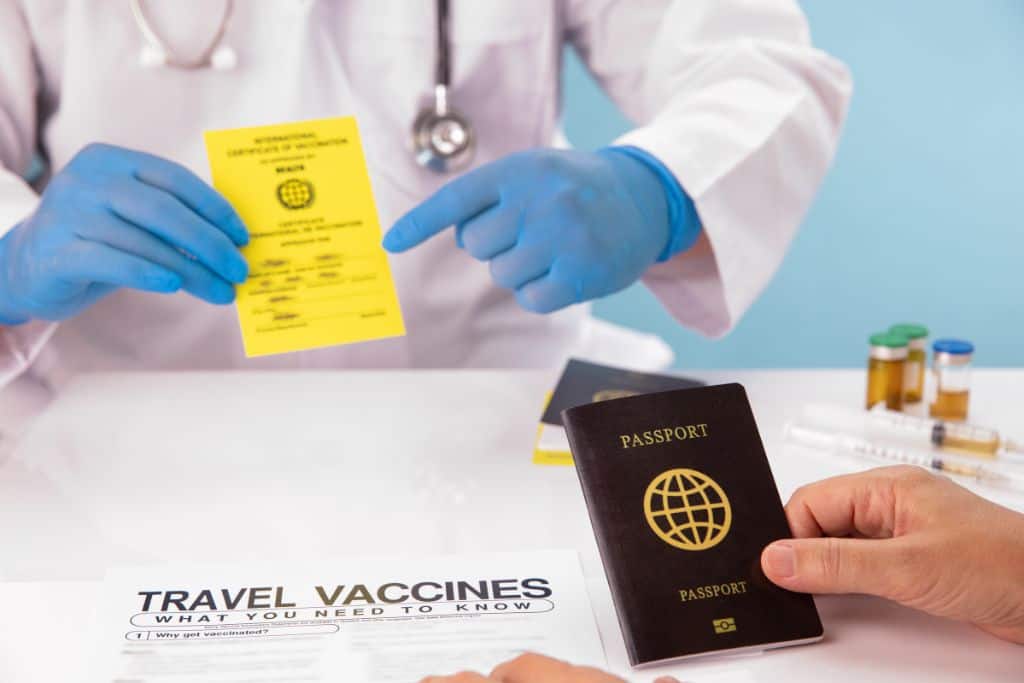
Vaccinations
Make sure your vaccinations are up to date, including hepatitis A and B, typhoid, and tetanus. Consider vaccines for Japanese encephalitis and rabies if you plan to spend a lot of time outdoors or in rural areas. Check with your doctor or review the Center for Disease Control’s website.
Water and Food Safety
Drink bottled or boiled water and avoid ice in drinks. Stick to well-cooked food and be cautious with street food, opting for busy stalls with high turnover. Using common sense will also go a long way toward keeping you and your belly safe.
Personal Safety Tips for Traveling to Laos
Protecting yourself against possible accidents, potential scams, and being aware of the local customs will make your trip to Laos less worrisome.
Travel Insurance
Obtain comprehensive travel insurance that covers health, accidents, theft, and cancellations. You can get this from your travel agent if they helped book your travel to Laos. You can also purchase yourself and find a plan that best suits your needs and for the length of time you are traveling.
Review this site for an idea of the different insurance companies available to you. This list is not comprehensive, but will be a good start. If you are not sure about what kind of travel insurance is best for you, contact a travel agent for assistance.
Scams and Theft
Be cautious of common scams, such as fake monks asking for donations or overpriced tuk-tuk rides. If you feel uncomfortable or think you are being scammed, you can ask for help from a local at your accommodation.
Do not be foolish and flash your expensive jewelry or equipment about. Keep your belongings secure and be mindful of pickpockets, especially in crowded areas.
Traveling with a cross body bag or one that sits close to your body can help keep your belongings safe. I traveled from Chiang Mai to Luang Prabang, Laos with a bag that sat flat against my front.
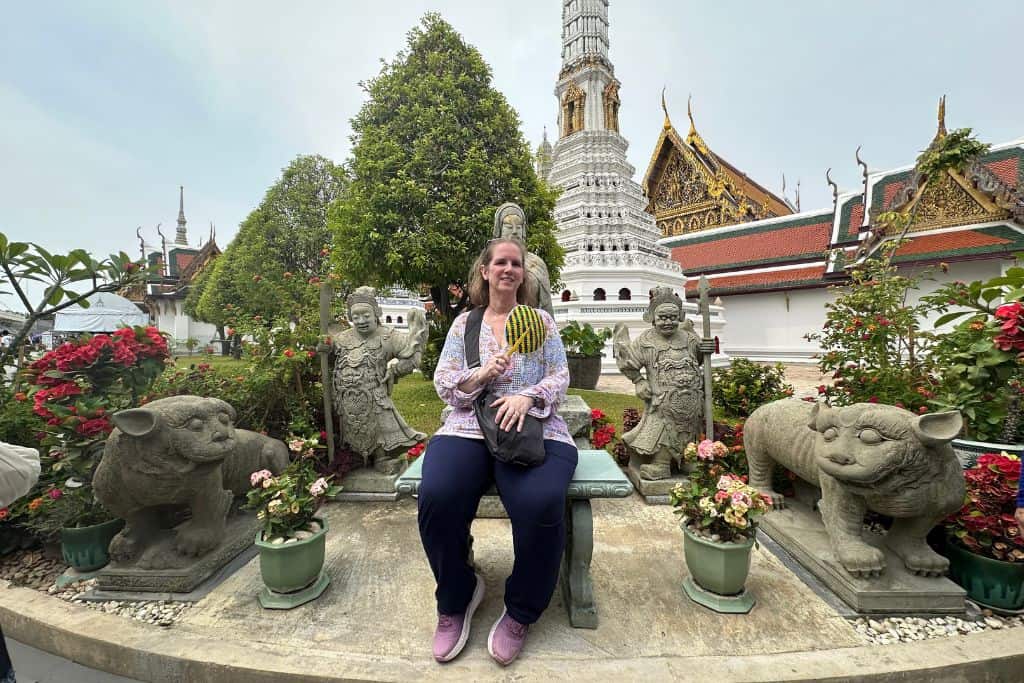
This bag could also be worn under a jacket and would be invisible as long as you didn’t overpack it. In my bag was my cell phone, my money, keys, passport, and a few other things. This kind of bag keeps your hands free and your personal items close to you for added safety.
4. Transportation Tips for Traveling to Laos
Road Safety
Roads can be challenging in Laos, with poor lighting and poor road conditions. Getting around the country can be difficult, but having this information ahead of time should help.
Road Conditions
Roads in Laos, especially in rural areas, can be in poor condition, with potholes, limited signage, and lack of lighting. Even in urban areas, the infrastructure may not be up to the standards you’re used to.

Driving Tips for Traveling to Laos
If you plan to rent a motorbike, scooter, or car, these tips should be very helpful.
-
- Licensing: Ensure you have a valid international driving permit.
- Helmet: Always wear a helmet when riding a motorbike or scooter.
- Speed: Drive at safe speeds and be extra cautious of unpredictable traffic patterns, including pedestrians, animals, and other vehicles.
- Night Driving: Avoid driving at night due to poor visibility and road conditions.
- Accidents: In case of an accident, contact local authorities and your insurance provider immediately. Knowing basic first aid can also be helpful in case of any injuries.
Keeping a cool head and following the country’s driving rules, and the above listed suggestions, should allow you to get around the country without any issues.
If something does happen, do not panic and contact authorities for assistance. If these suggestions make you a bit nervous, then perhaps you should try public transportation of some kind.
Public Transportation in Laos
There are several kinds of public transportation to choose from, which include buses, tuk-tuks, and songthaews.
Buses
Both long distance buses and more local buses are available for getting you from Point A to Point B. One thing I can suggest while traveling in Laos is to trust that you will reach your destination, but be flexible with your arrival times.
Buses usually operate from main bus stations or terminals. In the cities, there are usually designated central bus stations where most routes originate and terminate. More rural areas might have the pick up points being a local market or central square in the town.
Long-Distance Buses
Several companies offer long-distance bus services between major cities. VIP and sleeper buses are available for longer journeys, offering more comfort and space. Sleeper buses usually start right before it gets dark and you are assigned a bunk to sleep in while you travel at night.
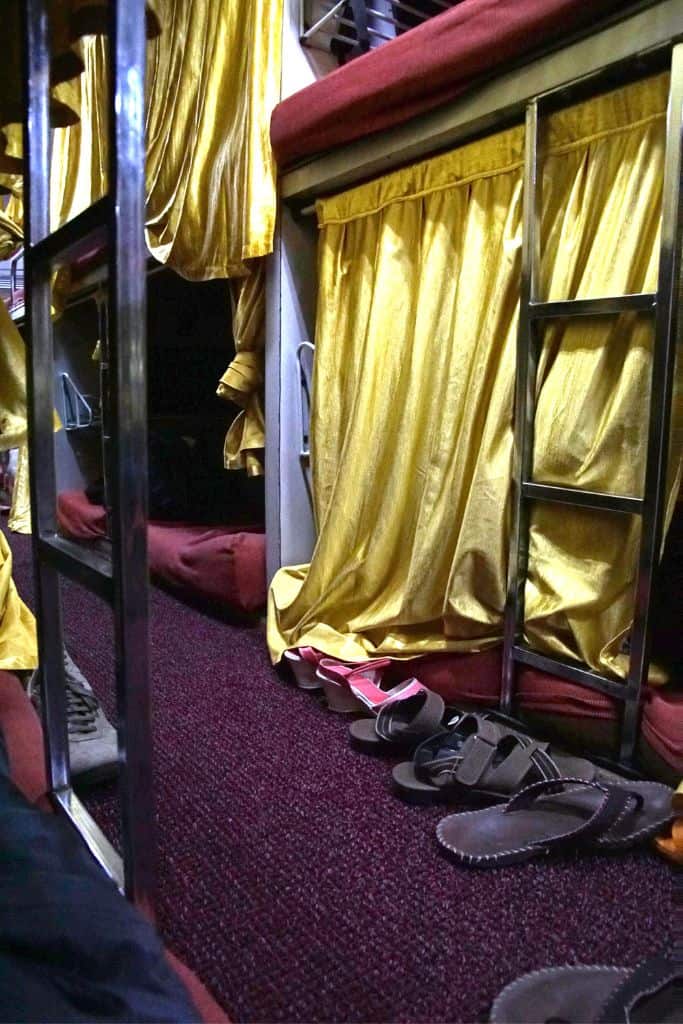
Pay attention when booking your bunk and make sure you claim the entire bed. If not you might end up sharing the bunk with a stranger for the night.
These long-distance buses usually offer more comfort and are air-conditioned. At major bus stations you may need to purchase tickets at the ticket counter or purchase your fare online before boarding.
Local Buses
These are often older and less comfortable, but they are an affordable option for shorter distances. Schedules can be irregular, so be prepared for potential delays.
Cities like Vientiane and Luang Prabang have bus service that covers specific routes within the city area. These can be very crowded during peak hours due to the low fares. It’s common for locals to bring various goods and belongings on board, adding to the busyness.
Local buses may not stick to a strict schedule so make sure to add some extra time and be flexible with your expected timeline. Bus frequency also varies with more frequent buses in the city and a bit fewer scheduled arrivals in rural areas.
These older local buses may not be as well maintained as the long-distance buses. Seats may be worn and buses may not have air conditioning.
Tuk-Tuks
These fun open-air vehicles are a great way to get around within the city for short trips. Usually found at busy intersections on the street, your accommodation can also help you arrange a ride. Drivers may have limited English, so write your destination down. Using popular landmarks can help.
Traditional Tuk-tuks
These are three-wheeled vehicles with a covered passenger area in the back. They are typically open on the sides, providing ventilation and views of the surroundings. Riding in a tuk-tuk is a cheap way to see the area as you travel from one place to another.
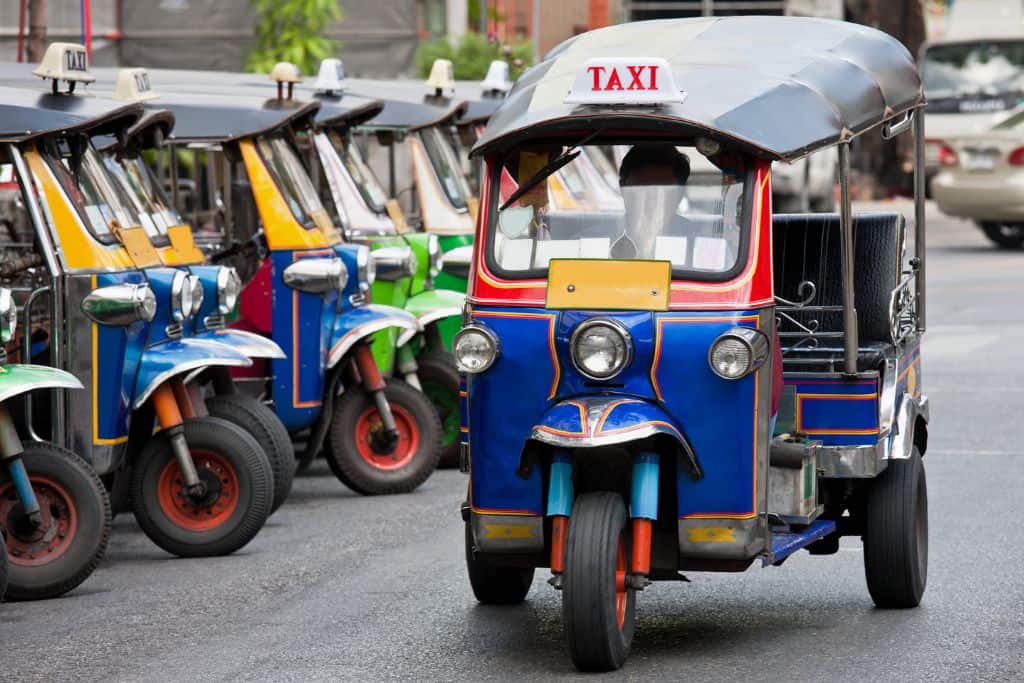
Tuk-tuks can usually accommodate 2-4 passengers, depending on the size of the tuk-tuk and the amount of luggage.
Jumbo Tuk-tuks
This size tuk-tuk can accommodate about 6-8 people and more luggage. This version has a longer body with more seating and is most often an individual hire or used for shared rides.
Negotiating Fares
Tuk-tuks are not metered. Always agree on the fare before starting your trip. Tuk-tuk drivers may quote higher prices, so bargaining is common. Have fun with your bargaining skills, but also remember to be aware of the conversion rates to be fair to your driver. You do not want to insult your driver by trying to reduce the fare by 5000 kip, which only equals out to $0.22.
Songthaews
These are shared pickup trucks with benches in the back. They operate on fixed routes but can also be hired for private trips. They are a cost-effective way to travel short distances. A songthaew is the way I traveled from the slow boat landing to the center of Luang Prabang with all of our luggage piled on top.
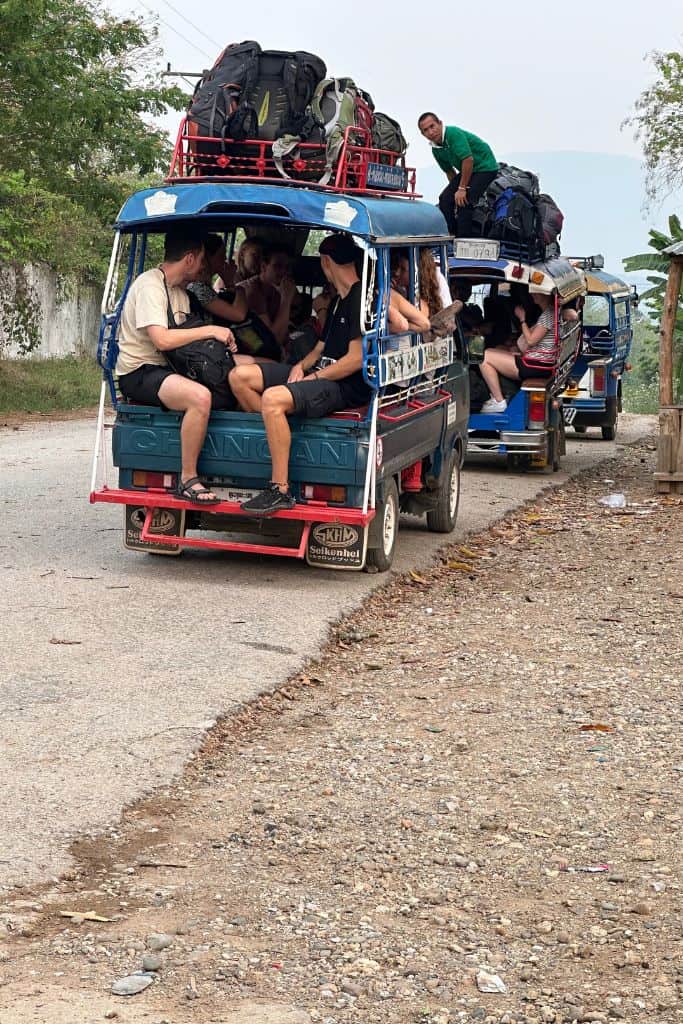
As you travel the streets of Laos you will see many of these open trucks with locals traveling to or from work. Generally operating on set routes, they can be an effective way to get to your nearby destination for a low fare.
5. Documentation Tips for Traveling to Laos
Traveling to Laos requires certain documents and steps be followed to explore the country legally. Follow these tips to be prepared.
Documents
Keep your passport, visa, and important documents in a safe place. Carry photocopies or digital copies with you.
Emergency Numbers
Know the local emergency numbers and have contact information for your country’s embassy or consulate in Laos. I also suggest keeping the contact information for your accommodation with you. Click here to access the emergency numbers in Laos.
6. Environmental Awareness Tips for Traveling to Laos
Wildlife and Nature
When trekking or exploring nature, use a guide to avoid getting lost and to stay safe from potential wildlife hazards. By following these tips, you’ll be better prepared for a safe and enjoyable trip to Laos. Enjoy your adventure and the beautiful culture and landscapes this country has to offer.
Animal Tourism
Avoid attractions that exploit animals, such as elephant rides or shows. Instead, support ethical sanctuaries where animals are well cared for. Many elephant sanctuaries allow you to feed and bathe the elephants, but not ride them.

Sustainable Travel
Be mindful of your environmental impact. Use refillable water bottles, avoid single-use plastics, and support eco-friendly accommodations and tour operators.
Weather Conditions
Be aware of the weather, especially during the rainy season (May to October), which can cause flooding and landslides. More about the weather in the next section.
7. Weather in Laos
There are several distinct seasons is Laos and the weather can vary widely between them. Here is an overview of the weather and what you should pack to be prepared for each season. These tips for traveling to Laos will keep you comfortable and ready for any weather.
Weather Overview in Laos
Dry season in Laos generally runs from November to April and includes the cool dry season and the hot dry season. Wet season covers the remainder of the year. Being aware of the temperatures and general weather will make your adventure so much more enjoyable since you will be prepared.
Cool Dry Season
- November to February
- Temperatures ranging from 15-25°C (59-77°F) in the northern parts of the country
- Can be slightly warmer in the south
- Weather is pleasant and cool, especially in the morning and evenings
Hot Dry Season
- March to April
- Temperatures ranging from 25-35°C (77-95°F) or even higher
- High humidity
- Weather is very hot, especially in April ( This is when I was there 🌞)
Wet Season
- May to October
- Temperatures ranging from 25-30°C (77-86°F)
- High humidity with potential for heavy rainfall
- July and August are the wettest months
- Rain often comes in short, intense bursts, so be prepared
8. Packing Tips for Traveling to Laos
Clothing
Taking the proper clothing for the weather, your activities, and your comfort are an essential part of your trip planning. Quick-drying and moisture-wicking clothing will keep you the most comfortable.
Lightweight and Breathable Clothing
Pack cotton or linen clothing to stay cool in the hot and humid climate. Loose-fitting clothes are recommended. Athletic or hiking wear with moisture-wicking features are also an excellent choice.
Warm Layers (for Cool Dry Season)
Bring a light jacket or sweater for cooler evenings and mornings, especially in the northern regions.
Rain Gear (for Wet Season)
You will want a lightweight, waterproof jacket, or plastic poncho. Bringing quick-drying clothes will keep you more comfortable when you get wet.
Make sure to have an umbrella. If you are outside any time during the rainy season, you might need it.
Comfortable Footwear
Sturdy walking shoes or sandals are recommended. Bring extra socks, if you wear them, to make sure your feet stay dry.
Waterproof shoes or sandals that can dry quickly are excellent for the rainy season.
Swimwear
You want to be prepared if you get the chance to go swimming or visit any of the waterfalls in Laos.
Accessories
Bringing the right accessories can help make your time in Laos so much better. These are necessities and shouldn’t be forgotten.
Sun Protection
- Wide-brimmed hat
- Sunglasses
- Sunscreen with a high SPF
Insect Repellent
This is essential to protect against mosquitoes, especially in the evenings
Other Essentials
- Reusable water bottle for staying hydrated
- Personal medications from home and a basic first aid kit
- Small daypack for carrying essentials while exploring
9. Connectivity Tips for Traveling to Laos
SIM Cards and Mobile Data
Upon arrival in Laos, purchase a local SIM card from providers like Unitel, Lao Telecom, or Beeline. You can find these at the airport, major cities, or local shops.
Opt for a data package that suits your needs. These are typically affordable and offer good coverage across most parts of the country.
Ensure your SIM card is registered with your passport details, as this is a legal requirement in Laos. At the point of purchase, the vendor will provide a registration form. You will need to fill out personal details, including your full name, passport number, and possibly your local address in Laos (hotel or guesthouse address).
You can also check with your current phone provider to see if they offer international coverage. This may be included in your plan or you may have to pay an additional fee.
My T-Mobile plan has worked in every country I’ve visited, including Laos. No additional fee for data and text, and a small per minute charge for phone calls. I made sure everyone just texted me.
Wi-Fi Access
In today’s connected world, having reliable wi-fi and internet access is critical. This is especially true if you are working while exploring Laos.
Hotels and Guesthouses
Most hotels, guesthouses, and hostels offer free Wi-Fi to guests. The quality of the connection can vary, so it’s a good idea to check reviews beforehand.
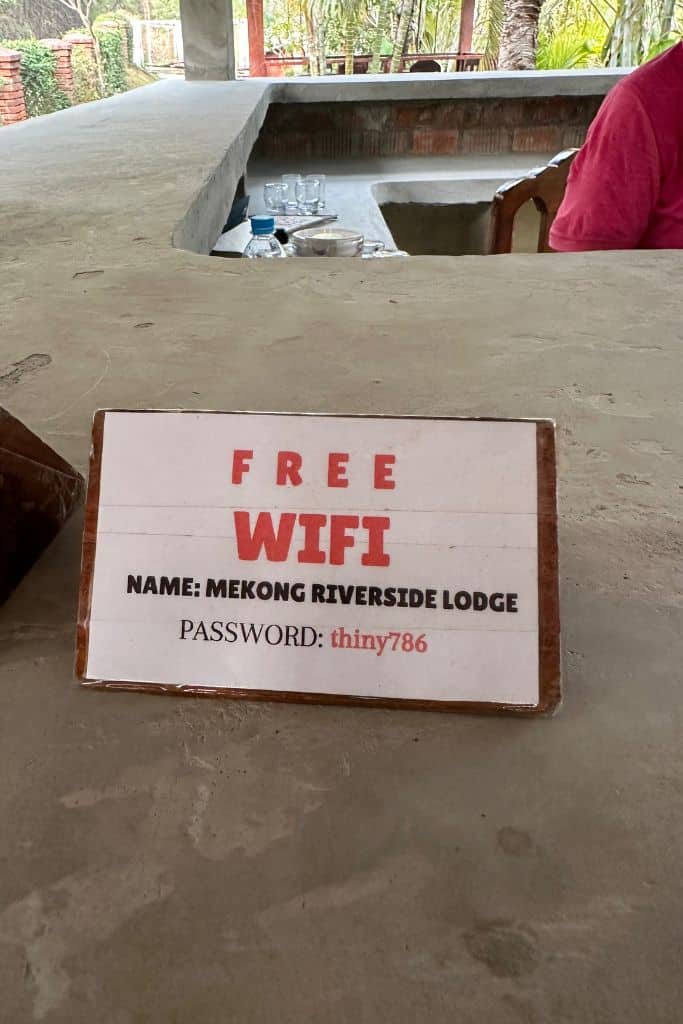
Cafes and Restaurants
Many cafes and restaurants in tourist areas provide free Wi-Fi. You might need to just ask for the password.
Co-Working Spaces
In larger cities like Vientiane and Luang Prabang, there are co-working spaces where you can access high-speed internet for a fee. These are so beneficial if you are on a working vacation.
VPN Services
Use a VPN to ensure your data is secure, especially when using public Wi-Fi networks. This is particularly important for activities involving sensitive information, like online banking. VPN stands for virtual private network. Check out some popular ones here.
A VPN can also help you access content that might be restricted in Laos. This can include certain websites and your favorite streaming services like Netflix or Prime TV. I used Nord VPN and it has worked wonderfully for me all throughout Laos.
Power and Charging
Laos uses type C, E, and F power outlets. Ensure you have the appropriate travel adapter. These can be purchased online or at some larger stores with an electronics department.

Carry a power bank for your devices, especially if you plan to travel to remote areas where charging options may be limited. These tips for staying connected will be crucial to ensuring continued power to your devices.
Offline Maps and Apps
Download offline maps from apps like Google Maps or Maps.me before you travel. This will help you navigate without relying on mobile data.
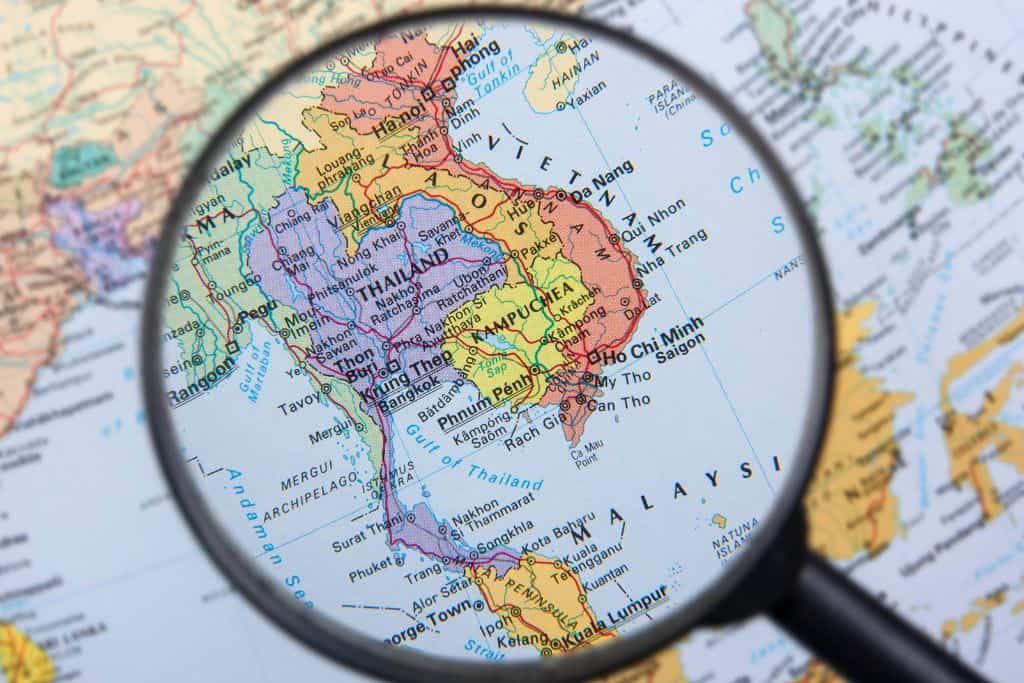
Consider downloading apps specific to Laos for travel guides, local tips, and language assistance. You can also purchase a travel guide with plenty of maps and recommendations of where to explore while in Laos.
Communication Apps
Use apps like WhatsApp or Facebook Messenger to stay in touch with family and friends. These apps work well with local data plans.
Apps like Google Translate can be helpful for overcoming language barriers. Google Translate can use voice recordings or take pictures of written foreign languages and translate to the language you want.
Local Internet Cafes
In more remote areas, you might find internet cafes where you can access the internet for a small fee. These can be handy if your mobile data is insufficient. These are also great places to strike up conversations with other travelers or locals.
Emergency Contacts
Save the contact information of your embassy or consulate in Laos, as well as local emergency numbers. You can also save your hotel or hostel’s phone number as well. Finally, having your emergency contacts back home can also be helpful if anything unfortunately happens to you. We hope not, but better safe than sorry.
By following these tips for traveling to Laos, you can give added reassurance to your loved ones, and feel safer yourself.
10. Cultural Sensitivity in Laos
When traveling to another country, especially if it is quite different from your own culture, it takes a little bit of understanding to make the trip more enjoyable.
Photography
Always ask for permission before taking photos of people, especially monks and in rural areas. Some places might have restrictions on photography.

There is so much to see and capture on your camera. Just be aware of who is in the scene and ask if you can take their picture. I took hundreds of pictures and nobody turned me down. It is still polite to ask.
Tipping
Tipping is not expected but appreciated for good service. A small tip for guides, drivers, and restaurant staff is a nice gesture. I had many people turn down my offer of a tip when they carried my luggage up the crazy cement steps from the Mekong River.
The Laotian people are friendly, helpful, and humble. Tip if you wish to show additional appreciation, but it is not mandatory or expected in the same way as in the United States.
Dressing Appropriately for Temples
I know this has been mentioned before, but you must be respectful, and prepared, when visiting the multitude of temples in Laos. Many travelers minimize their luggage and do not have anything appropriate to wear to enter a temple.
If you do not have something to cover your shoulders or your knees, you may be denied entry. Some temples allow you to rent or borrow a covering. Just be aware of where you are visiting and dress accordingly to show respect for their culture.
11. Food and Drink in Laos

Laos cuisine is known for its rich flavors, fresh ingredients, and unique dishes that reflect the country’s cultural heritage. Here are some popular foods.
Laap (Larb)
A traditional dish made from minced meat (chicken, beef, pork, or fish), mixed with herbs, lime juice, fish sauce, and ground rice. It’s typically spicy and served with fresh vegetables and sticky rice.
Tam Mak Hoong (Papaya Salad)
A spicy and tangy salad made from shredded green papaya, tomatoes, chilies, lime juice, and fish sauce. It can be quite spicy depending on the amount of chili used.
Sai Oua (Lao Sausage)
A flavorful pork sausage seasoned with herbs, spices, and sticky rice. It’s often grilled and served with vegetables and sticky rice.
Khao Piak Sen
A comforting noodle soup made with thick rice noodles, chicken or pork, and a savory broth. It’s less spicy compared to other Lao dishes.
Mok Pa (Steamed Fish)
Fish steamed in banana leaves with herbs and spices, often served with sticky rice.
Sticky Rice (Khao Niew)
Sticky rice, or “khao niew,” is the heart and soul of Lao cuisine and culture. It is more than just a staple food; it’s a symbol of community and tradition.
Sticky rice accompanies almost every meal and is often eaten with the hands, fostering a sense of sharing and togetherness. Its preparation and consumption are deeply ingrained in daily life and ceremonies, reflecting the agricultural heritage of Laos.
Sticky rice’s central role in Lao culture underscores its importance in social gatherings, religious rituals, and familial bonds, making it an enduring symbol of Lao identity and hospitality.
Spiciness Levels
Laos cuisine is generally flavorful and can range from mild to very spicy. Dishes like laap and papaya salad can be particularly spicy, but the heat level can usually be adjusted to taste.

If you prefer milder food, it’s always a good idea to ask for less chili when ordering. Other dishes, like noodle soups, tend to be less spicy and can be a good option for those who are sensitive to heat.
Overall, Laos offers a diverse culinary experience with dishes that cater to a variety of spice preferences. Enjoy exploring the rich and vibrant flavors of this Southeast Asian cuisine!
Drinks in Laos
Here is a list of 10 common drinks you can find in Laos.
- Beerlao: The national beer of Laos, known for its light, refreshing taste.
- Lao-Lao: Traditional rice whiskey, often homemade and quite potent.
- Nam Houm: Herbal tea made from a variety of local herbs, believed to have medicinal properties.
- Lemonade: Freshly made with local lemons, often enjoyed cold.
- Fruit Shakes: Made with fresh tropical fruits like mango, pineapple, and papaya.
- Coconut Water: Fresh from the coconut, providing a hydrating and refreshing drink.
- Iced Coffee (Cafe Lao): Strong, sweet coffee served over ice, often with condensed milk.
- Green Tea: Commonly served in local eateries and homes.
- Tamarind Juice: A sweet and tangy drink made from tamarind fruit.
- Sugarcane Juice: Freshly pressed sugarcane juice, sweet and cooling.
These drinks offer a refreshing complement to the rich and flavorful cuisine of Laos. I also drank several cups of traditional Lao coffee which is strong and delicious.
More Laos Blog Posts Mekong River Slow Boat to Luang Prabang Mekong Riverside Lodge
In Conclusion – Tips for Traveling to Laos
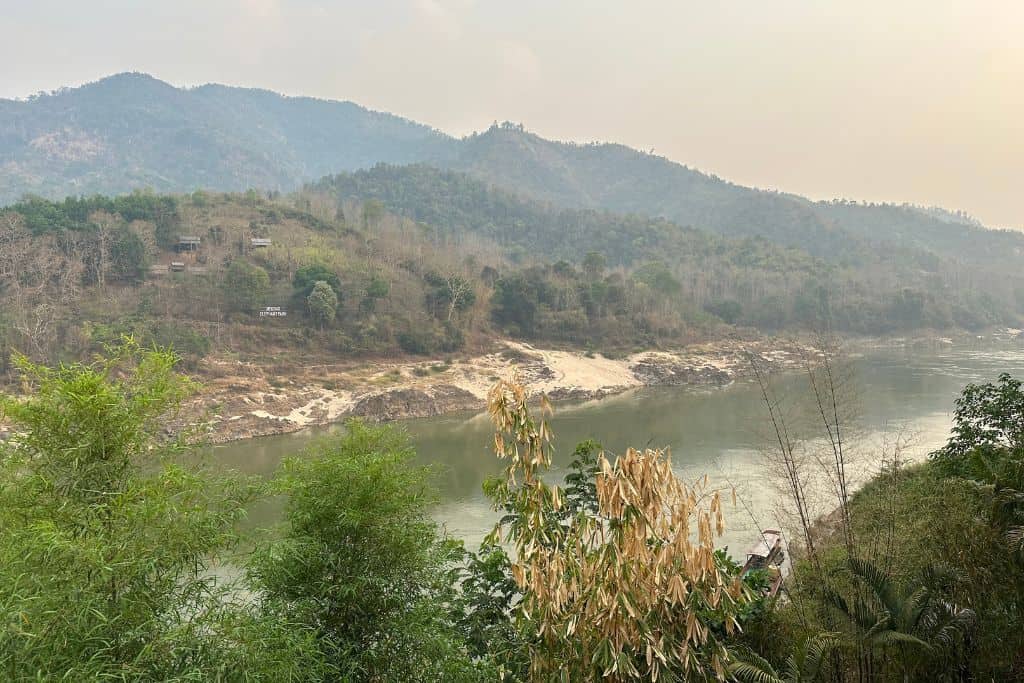
From the majestic Mekong River winding through verdant valleys to the enchanting temples of Luang Prabang, Laos beckons with a promise of adventure, tranquility, and discovery.
Whether you’re seeking spiritual solace, thrilling outdoor activities, or simply a taste of authentic Southeast Asian life, Laos presents a unique travel experience that is both enriching and unforgettable.
Laos is a beautiful and welcoming country with much to offer. Enjoy your travels armed with more knowledge about the country and the unique experiences that come with exploring this enchanting destination!

